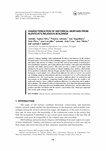 |
António Santos Silva, Patrícia Adriano, Ana Magalhães, João Pires, Ana Carvalho, António João Cruz, José Mirão, António Candeias, "Characterization of historical mortars from Alentejo’s religious buildings", International Journal of Architectural Heritage, 4(2), 2010, pp. 138-154, doi:10.1080/15583050903046322 |
| Abstract |
Alentejo's religious buildings reflect undoubtedly the history and character of this southern Portugal region. Conservation of these buildings requires a deep knowledge of their masonry and renders' lime mortars to evaluate correctly their state of conservation, to avoid progression of pathologic situations, and to plan efficient interventions, with repair and substitution materials with similar characteristics. This article presents a synthesis of the main results obtained in the mortar characterization of religious buildings from Alentejo, which include Évora and Elvas Cathedrals, Mértola Mosque, and the Church of Amieira do Tejo. For each monument, several samples were collected from different sites and a set of tests was carried out, including chemical, mineralogical, and micro-structural tests, as well as physical and mechanical tests. The tested mortars correspond to different phases of construction and interventions on the buildings, comprising mainly origin periods from the twelfth to the eighteenth centuries; hence exhibited significant differences in composition and in application techniques. The obtained results of composition have given important information about the provenance of the materials used, including binder and sand types, and also about decay products and their correlation with the mortar's conservation state, which gave important clues on the repair strategy to adopt. |
